FRIDAY
FEBRUARY 28 - 2014
Hollybank
Woods
10:00 - 11:00 - It was
a fine sunny morning, just right for a short walk
around our lovely local woodland. The Friends of
Hollybank Woods have been very busy coppicing and
there are several stacks of Sweet Chestnut poles.
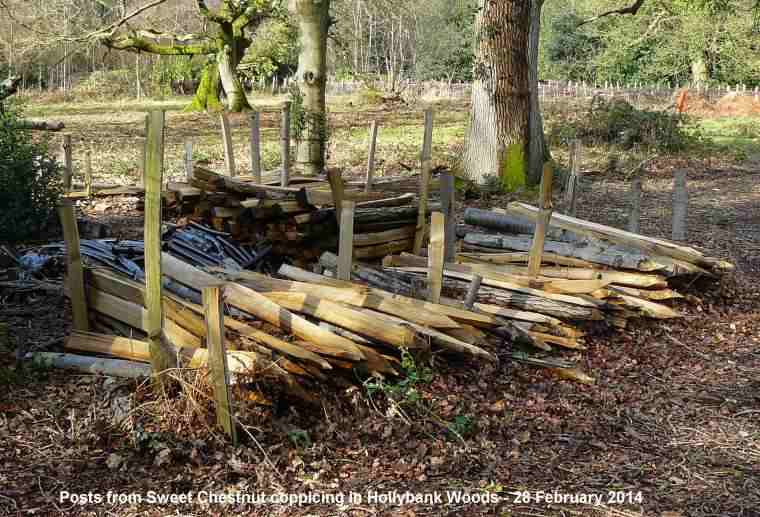
In the Jubilee
plantation area to the north of the Holly Lodge
clearing the new hedgerow has been reinforced with
woven dead hedging and there are some very informative
notices explaining what the group are doing.
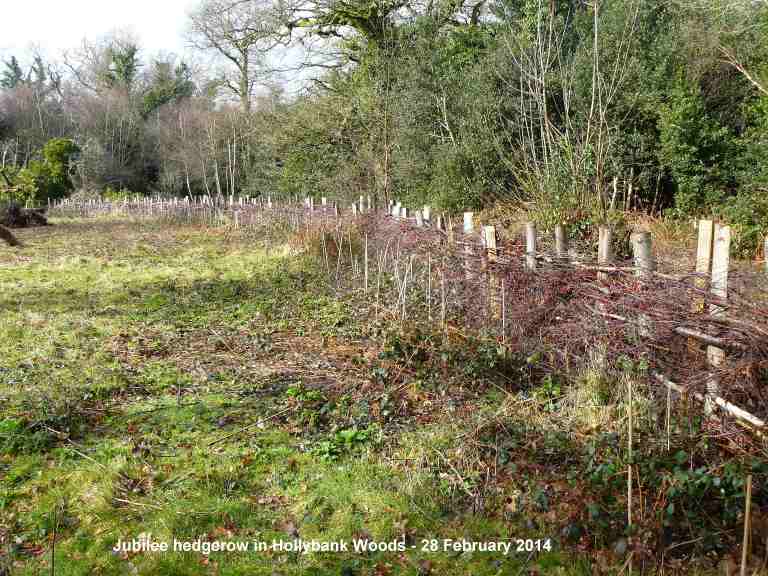
A fine Mistle
Thrush was singing strongly near the southern
entrance to the woods when I arrived. Most of the
common woodland birds were heard including Buzzard,
Green Woodpecker, Jays calling harshly and a couple of
Nuthatches. Bluebell leaves are showing well in the
usual places, but no sign of any flowers as yet. They
won't be out until the end of March at least. Although
it was a warm sunny morning I was disappointed not to
see any butterflies during the walk.
Mergansers
on the millpond
Jennifer Rye reported
seeing the male-female pair of Red-breasted Mergansers
on the town millpond this morning.
Bumblebees
at Stansted
I went back to the
Stansted Garden Centre to have another look at the
Bumblebees feeding on the arrays of Pansies for sale
in the outside area. There were not nearly as many as
on Wednesday, but I managed to get a better photo of
one which appeared to be asleep. I am fairly sure they
are Buff-tail Bumblebee (Bombus
terrestris).
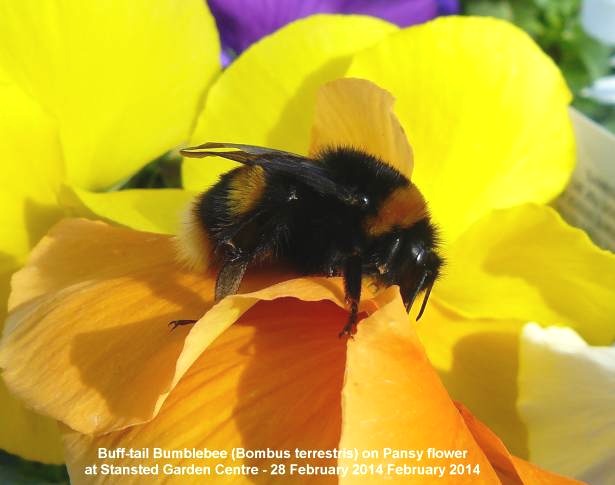
Wayside
flowers
I had a walk along the
footpath beside the Southleigh Road (west) wayside.
The council really cut this verge closely this year
and there is no sign of the bushes and trees which we
used to have here. I found several very good patches
of flowering Lesser Celandines.
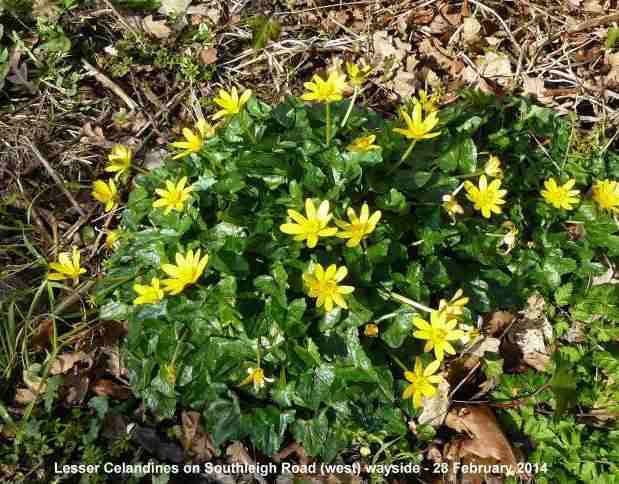
Flowering plants on
the traffic island in Horndean Road included Common
Stork's-bill, Danish Scurvygrass (with egg-shaped
pods) and Sticky Mouse-ear (with compact flower
clusters - not open). I also noted the presence of
Biting Stonecrop not in flower.
Mystery
Bittercress
A couple of patches of
Bittercress were flowering near the 40 mph sign at the
eastern end of the Southleigh Road (west) wayside.
From their tall size and wavy stems my first
impression was of Wavy Bitter-cress. However, from the
samples I brought home to look at under the microscope
I found that most of the flowers had 5 stamens, some
had 4 stamens, but none had 6. This is puzzling since
the main way of distinguishing the two bittercresses
is that Wavy Bitter-cress has 6 stamens and the very
similar Hairy Bittercress 4 stamens. Blamey, Fitter
and Fitter says Hairy Bittercress ''usually' has 4
stamens, implying it may at times have more or less.
The habitat on a roadside suggests Hairy as does the
early flowering.
Sandbags
gone!
The wall of sandbags
that was on the edge of the river in the north-east
corner of Brook Meadow to prevent flooding has gone.
The white bags are clearly visible in the river and
the black ones are probably there too. Also, a small
channel has been dug in the river bank at this end of
the wall which would take the water onto the meadow,
though the level is not high enough at present for
this to happen. This latter work looks like the
Environment Agency. One of the Brook Meadow
Conservation Group volunteers saw the three lads who
threw the sandbags into the river on Wednesday (Feb
26). She has a description and the matter has been
reported to the police.
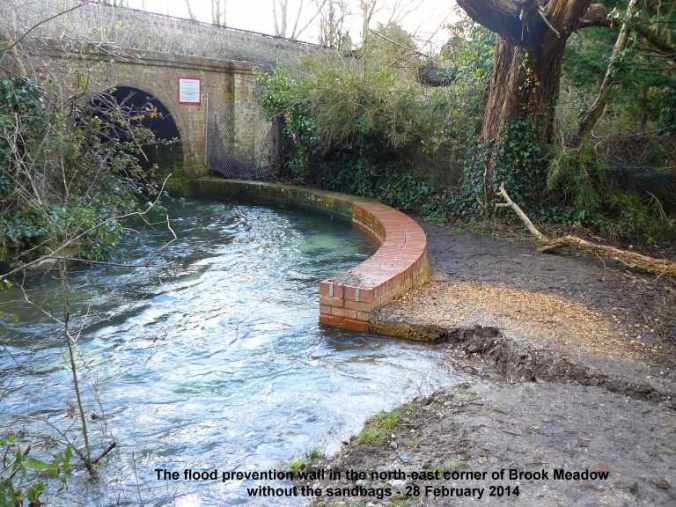
For news and photos
about this year's floods on Brook Meadow
Go to . . . http://www.brook-meadow.hampshire.org.uk/bm-flooding-2014.html
THURSDAY
FEBRUARY 27 - 2014
Nore
Barn
12:00 - About 2 ½
hours after high water. Two Spotted Redshanks
were in the stream with a Greenshank, no rings.
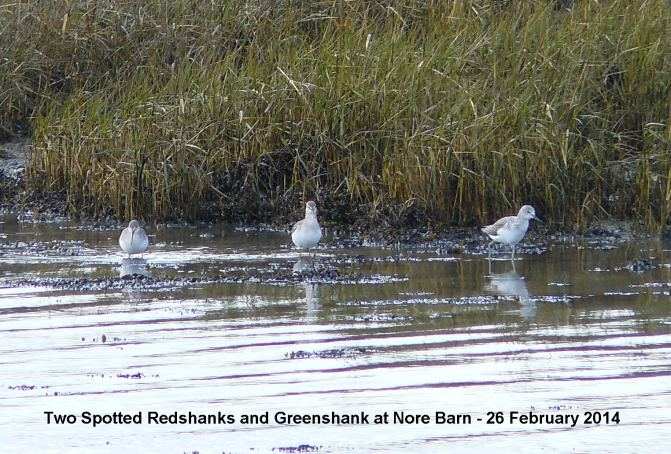
There was not much
else to see in the harbour apart from a few Brent
Geese, Wigeon and Teal. I think the big exodus has
begun.I counted 48 Brent Geese feeding on the pond
field at the top of Nore Barn Creek. There was much
chasing with heads down suggesting courtship rituals
prior to migration.
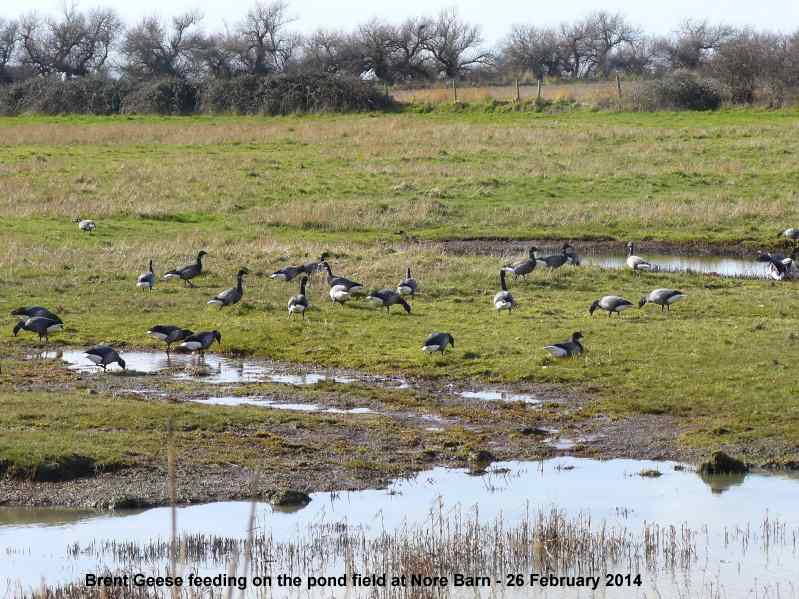
The first
Blackthorn flowers are now showing on the shore
south of Nore Barn Woods.
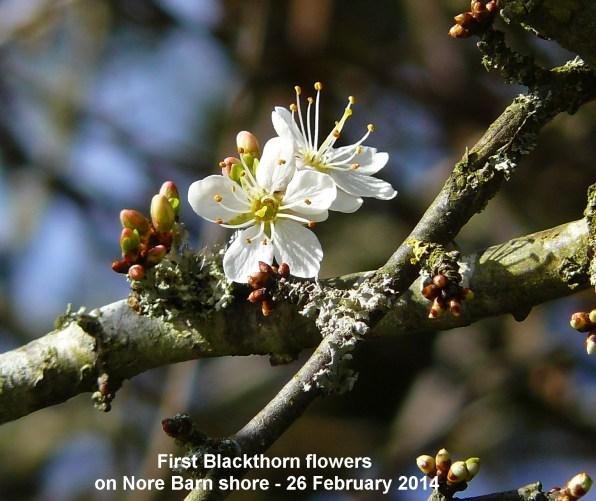
Warblington
Peter Milinets-Raby
had a walk down Wade Lane to Langstone Mill Pond, then
along the Warblington shore to Conigar Point and back
(10:05am to Noon - High tide throughout).
Along Wade lane: 2 Redwing, 2 Mistle Thrush, 2 Pied
Wagtails, 19 Little Egrets in the muddy horse paddock
(through by the end of the walk they had all moved to
the paddock by the millpond).
Horse paddock north of millpond: 63 Teal, 20
Moorhen.
Langstone Mill Pond: 2 Mute Swans (pair, so still
present - see note later), 7 roosting Little Egrets
and 1 Grey Heron.
Along shoreline before Pook Lane; 7 Red breasted
Mergansers, 1 dead male Mute Swan (half eaten, no
rings).
Fields by Warblington Cemetery: 1 lone Brent Goose, 16
Oystercatchers, Buzzard.
In field adjacent to cemetery: 130+ Black-headed
Gulls, 194 corvids and 6 Med Gulls (one full summer,
the others with incomplete hoods - lots of
calling).
Off Conigar Point; 43 Wigeon, 165 Brent Geese swimming
just off shore with Black Brant.
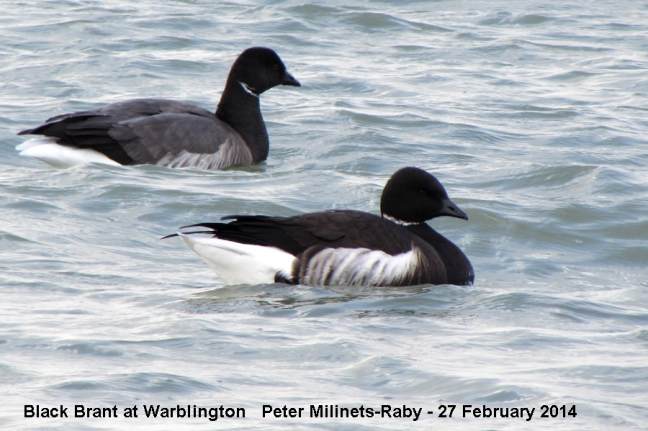
WEDNESDAY
FEBRUARY 26 - 2014
East
Stansted walk
Jean and I had a very
pleasant walk through the east park of Stansted on a
glorious sunny morning. We made a round trip from the
Pavilion cafe up the tarmac road to the cottages near
Oak Copse where Sonya used to live and back along the
track to the Iron Gate Cottages and to the cafe for a
welcome coffee and scone. I had my traditional photo
taken between the magnificent twin Oaks at the top of
the tarmac road just before Lumley Croft. I love the
way these two huge tree have grown together over the
years.
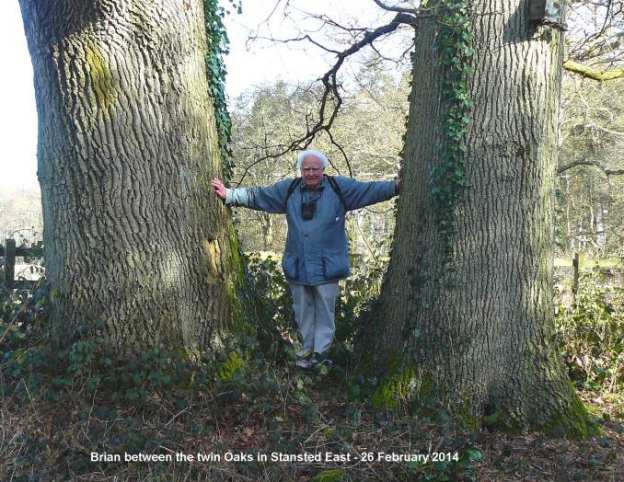
We met Michael Prior
on the track near the 5 ways junction. He stopped for
a chat and told us to look out for the Woodlarks in
the large field south of Lumley Croft and
Yellowhammers in the hedge towards the Iron Gate
Cottages. Michael also said there had been flocks of
Fieldfare and Redwing on the fields and Ravens
overhead with the occasional Red Kite.
Ravens
Of the birds mentioned
by Michael the only one we saw were the Ravens and
what beautiful birds they were. We heard their croaks
as we turned into the path in front of Stansted House
as two of them flew over towards the conservation
field. One of the Ravens actually perched on the fence
beside the footpath before going onto the field; I was
surprised at how tame it was, tolerating the close
approach of a walker with a dog.
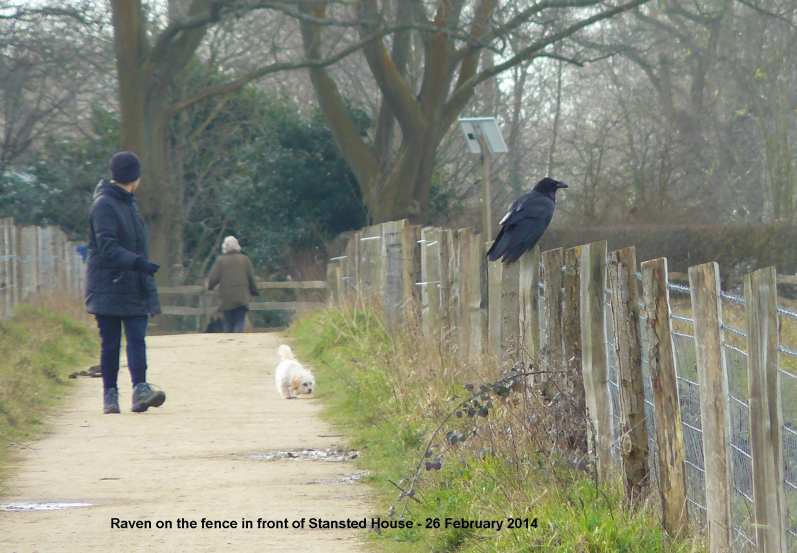
The two Ravens then
settled for a while on the field where they dwarfed a
pair of Carrion Crows. After I had taken a few photos
they took off and flew south out of sight. Just look
at that bill.
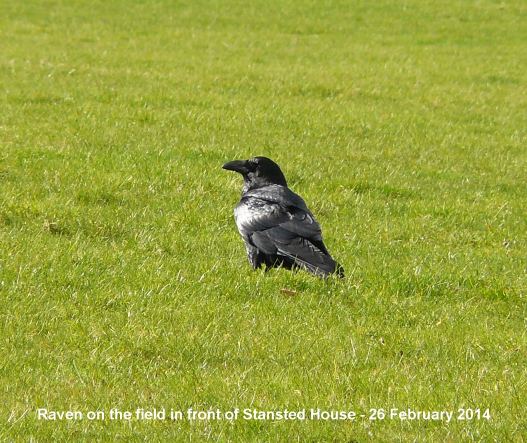
Mistle
Thrushes
Another highlight of
the walk was to hear the magnificent song of two
Mistle Thrushes, one near the Iron Gate Cottages and
the other near the Oak Copse cottages. Michael said
there were often several pairs on the estate and he
has seen flocks of 30 or so feeding on the fields in
winter. Most of the other common woodland birds were
singing, with Chaffinches particularly numerous; they
really have got going. However, I have yet to hear a
good Blue Tit song.
Bumblebees
After coffee in the
cafe, we had a look around the garden centre where
dozens of large bumbling Bumblebees were feeding on
the flowers in the outside area. From the yellow bands
on thorax and abdomen and the dirty white tails, I
think they were Queen Buff-tail Bumblebees
(Bombus terrestris). These will be
insects fresh from hibernation and busy building up
their energy reserves on the flowers before searching
for nesting sites.
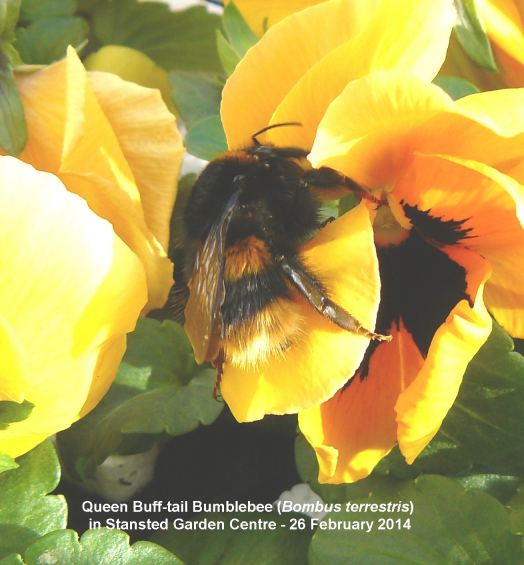
Also feeding on the
flowers in the garden centre were various hoverflies
including Marmelade Flies and Drone Flies.
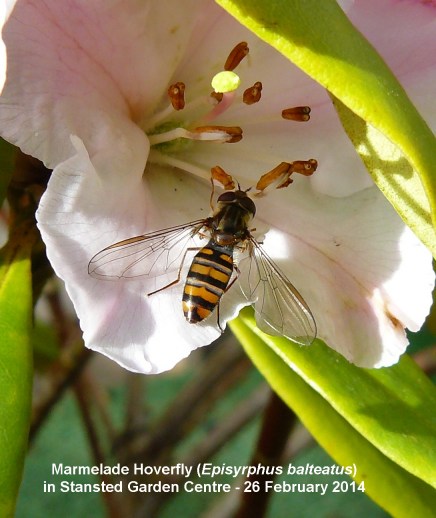
Ralph
Hollins comments
"Another sign of
spring comes from Brian Fellows who saw the first two
hoverflies that I have heard of this year - Episyrphus
balteatus (the 'Marmelade Fly') of which he captured a
good image and the Drone Fly (Eristalis tenax). I was
already aware that Drone flies regularly hibernate and
can be seen early in the spring but I was not aware
that the Marmelade Flies did so and so I tried to find
out more about their life cycle and I find that even
the Natural History Museum website is cagey on the
subject saying .. "The spring generation is thought to
arise from overwintering adults, and may be absent
following a cold winter." As this has been the
opposite of a cold winter I assume this insect has
overwintered in this country but if our population
were to be killed off by a cold winter they would soon
be back here as they regular long-distance migrants in
massive numbers. This is nevertheless a very early
sighting - an RSPB webpage indicates that they are
rarely seen in Britain before May and the
'Encylopaedia of Life' says .. "There are sometimes
two generations of fly per year in the UK - one in
late spring, the other from mid-summer to early
autumn. The spring generation is thought to arise from
overwintering adults, and may be absent following a
cold winter."
Flooding
news
This afternoon I had a
walk through Brook Meadow where the River Ems remains
very high, but the level is gradually going down. The
Environment Agency have replaced the third plank in
the sluice gate thus preventing water going down onto
the south meadow. The result of this is that the south
meadow flood has almost disappeared, leaving just
large puddles.
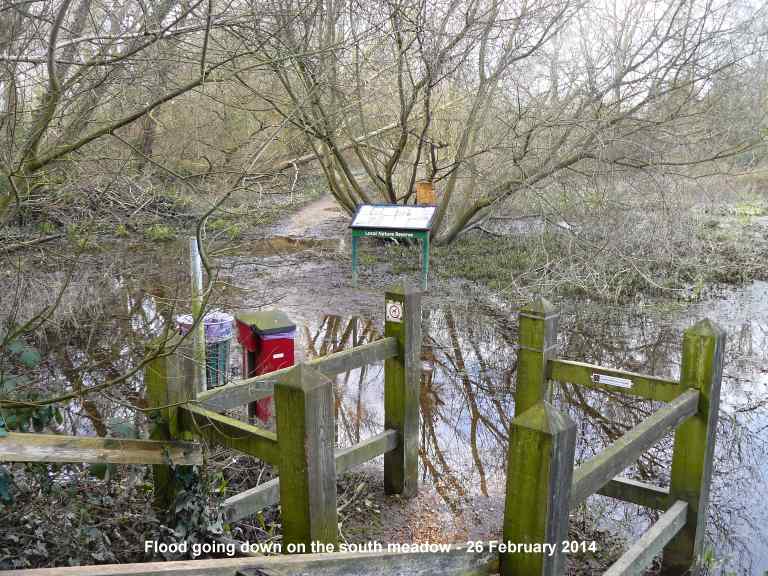
Peter
Pond swans
I had another look at
the swan pair on Peter Pond. I am now certain that
this is not the pair that nested here last year and
produced 8 cygnets of which only one survived. The
male (cob) has a metal ring on its left leg which last
year's did not have and the female (pen) has standard
black legs, whereas last year's female was a 'Polish'
swan with pink legs. The pair very conveniently
upended to show me their legs as in the following
photo. The one on the right is the male. You can just
see the metal ring on its left leg.
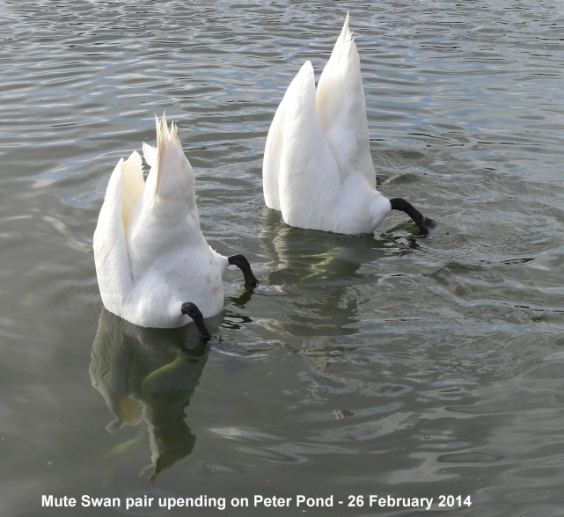
I believe I have been
seeing the original Peter Pond pair with their cygnet
at Nore Barn during the winter period, though I cannot
be 100% sure. It will be interesting to see what
happens if and when this pair returns to Peter Pond to
find their nesting territory taken over. There could
be trouble!
Millpond
swans
The town millpond
remains empty of water, but for the channel created by
the flow from the Westbrook Stream. As I walked along
Bridgefoot Path this afternoon at about 3pm, the
female swan of the north pair was on the site of last
year's nest near the bridge. The swan indulged in a
little preliminary nest building activity by picking
up one or two twigs. There is, in fact, an abundance
of twigs and other debris in this area of the pond
from recent storms, so it should not be necessary to
build a nest mostly from litter as happened last year.
It seems fairly likely that both pairs of swans
currently on the millpond will nest there this year.
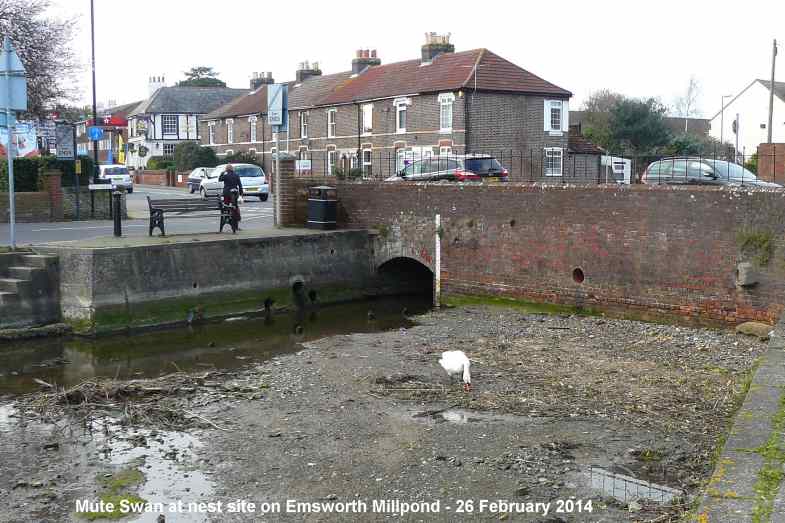
TUESDAY
FEBRUARY 25 - 2014
Peter
Pond Swans
The Mute Swan pair was
back on their breeding territory on Peter Pond this
afternoon. However, the male has a metal inscribed
ring on its left leg, which I have not noticed before
which suggested that this may be a new pair from last
year. Also, the female last year was a 'Polish' form
with pink legs but, from what I could see today, the
legs of the pen were the normal black colour, though I
shall need to check this out.
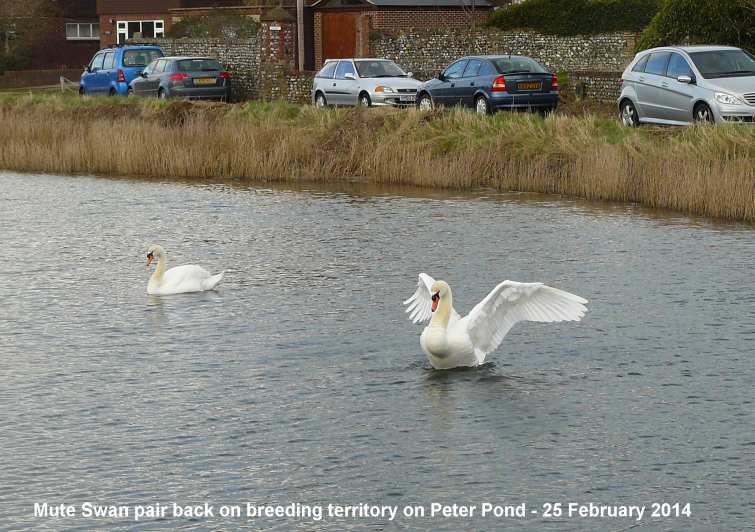
Bridge
Road Speedwell
I found what I am
fairly sure is Common Field Speedwell in flower on the
Bridge Road Wayside this afternoon. I was tempted to
go for Slender Speedwell which is, in fact, far more
common on the wayside but the triangular shaped leaves
seem conclusive. The leaves would be much more rounded
in Slender Speedwell.
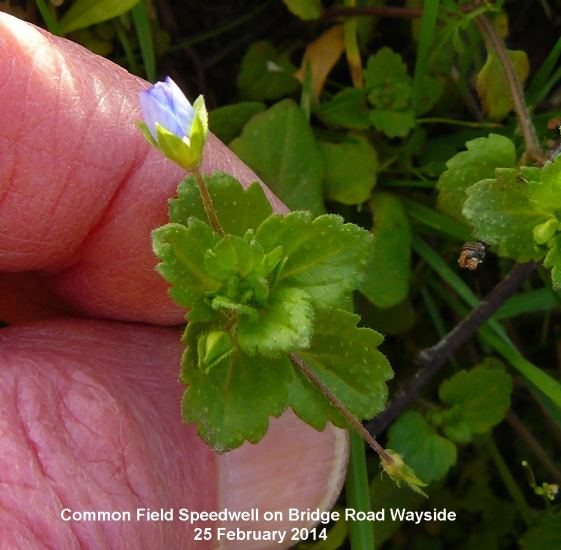
Mystery
fish in Westbrook
I had a look over the
wall at the end of my garden and saw lying in the
shallow water of the Westbrook Stream a large dead
fish. It was about 18 inches long and mainly silvery
in colour with orange and black marks. I really know
very little about fish, but this looked like a an
ornamental type from someone's pond. I have heard
stories about fish like Carp being washed out of
garden ponds by the floods and I suppose this could be
such a case.
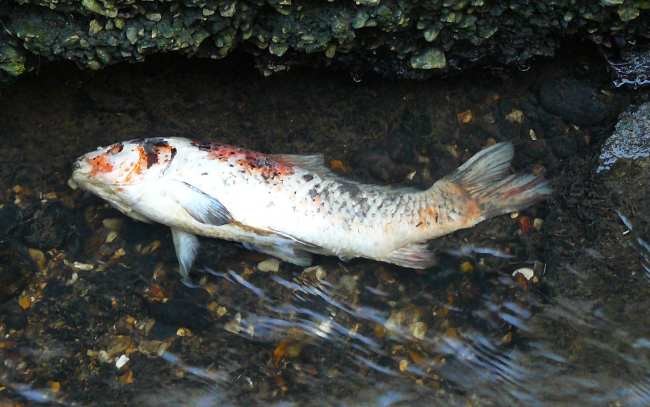
Nore
Barn
Peter Milinets-Raby
had a look at Nore Barn from 1:30pm to 2:45pm - very
low tide. Not much to be seen as it was low tide,
though he was surprised to find 2 Oystercatchers, a
Grey Plover, a Redshank and a Little Egret in the
stream. In the pond field were 41 Brent Geese and
another Little Egret. Off the "real" Conigar Point
were 4 Turnstone and out in the distant channel were 5
Red Breasted Merganser. In the stubble fields behind
the point were 101 Stock Doves (see photo) 9 Skylarks
and 12 Curlew
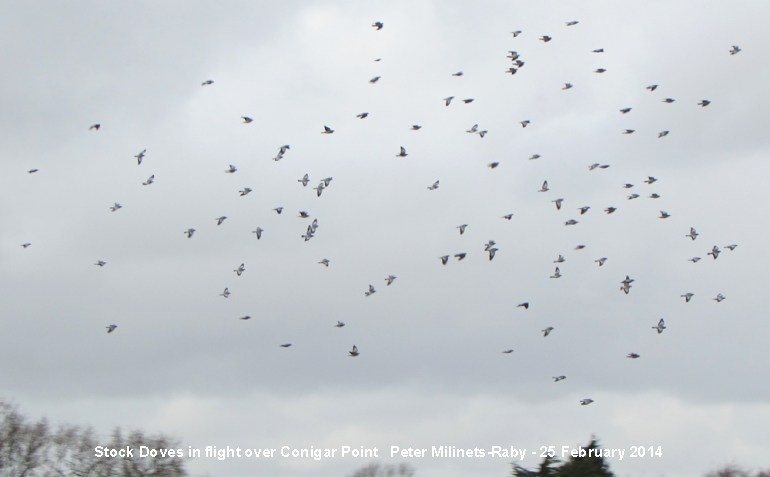
Hogboy
update
Graham Petrie sent me
an up date about the Hedgehog that he has been looking
after and which he has named Hogboy. Hogboy has not
gone into hibernation as might be expected for a
Hedgehog, probably due to the very mild weather, but
all seems well. He weighs a steady 850grams and a tin
of catfood lasts him about 3 days, supplemented with a
small handful of cat biscuits each day and the
occasional mealworm for a treat. His bedding area is
not changed every time so as not to disturb him too
much. Graham hopes to build a hedgehog house for him
in the garden.
MONDAY
FEBRUARY 24 - 2014
Spring
news
As I was delivering
the Brook Meadow e-mail notes to Ted and Penny Aylett
in The Rookery, I met their neighbour Paddy who told
me that a friend of hers has a mass of
frogspawn in her small pond. Paddy does not
have any in her own pond as yet.
The bright yellow
flowers of Lesser Celandine are now starting to
pop up around the Brook Meadow site, not in vast
numbers, but dotted here and there and good to see.
Chris Oakley was out
at Goodwood today where a flock of Southdown sheep
have started lambing.
Ralph Hollins reported
in his weekly summary that in the past three days
there have been reports of 7 Brimstones, 4
Peacocks, 10 Small Tortoiseshells and 2 Red Admirals.
Other
news
The level of the River
Ems continues to fall on Brook Meadow. The flood in
the south meadow is also falling quickly. There is a
good patch of Petty Spurge growing alongside the new
hedgerow on the Seagull Lane patch. The fern Common
Polypody is still growing from beneath the north side
of the north bridge. I first recorded this plant in
Oct-12.
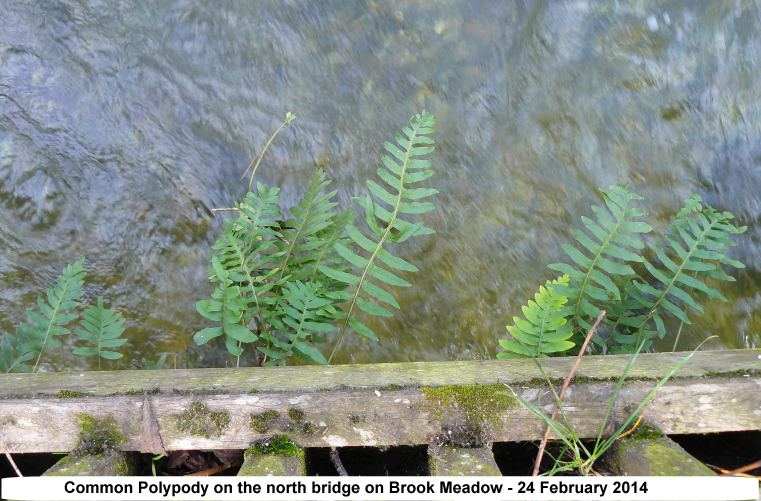
Brent
Goose feeding habits
Ralph Hollins
challenged my remark in the last wildlife news summary
that Brent Geese have returned to the harbours 'having
exhausted their inland feeding sites'. See . . .
Wildlife
News Summaries.
Rather, Ralph suggested the geese have returned to the
harbours to feast on a new growth of their favoured
foods, namely Eel Grass and Sea Lettuce.
He said, "It is my
impression that the recent storms and sea surges have
been the trigger for a change in the behaviour of the
geese - walking the shore between Langstone and
Emsworth recently I have noticed much more Eel Grass
and Sea Lettuce, etc than is usual for the time of
year and I think this may be the result of the storms
keeping the geese away from the shore and thus
allowing the sea vegetation to grow (along with mild
weather favouring growth). On a couple of recent
occasions when I have been on the Hayling shores just
before high tide (when the water floods the ground on
which the Eel grass grows, lifting it and making it
easier for the Geese to 'harvest') the Brent leave the
fields where they have been grazing and fly to the
harbour shores to enjoy their preferred
food."
Langstone
shore birds
Peter Milinets-Raby
took a walk down Wade Lane this morning to Langstone
Mill Pond, then along to Pook Lane (10:20am to Noon -
Low tide). Highlights were . . .
Along Wade Lane: 9 Little Egrets feeding in the
muddiest horse paddock, 3 Pied Wagtails, 2
Buzzard.
Flooded paddock just north of the millpond: 53 Teal, 1
Little Egret, 6 Mallard, 23 Moorhen, Adult Med Gull
flying over calling.
Langstone Mill Pond: male Reed Bunting singing, 1
Roosting Grey Heron, with 3 Little Egrets, 2
displaying Grey Herons on what looks like a nest.
Stock Dove.
Mill outflow stream: Greenshank (colour ringed with
tag. no details due to sun), Knot, Grey Plover, 16
Bar-tailed Godwits, 2 Red Breasted Mergansers.
Off Pook Lane: 233 Golden Plover, 3 Knot, 35
Bar-tailed Godwit, 350+ Dunlin, 44 Lapwing, 3
Greenshank (too distant), 2 Black-tailed Godwits, 17
Grey Plover, Great Crested Grebe, 33 Shelduck, 4 Red
Breasted Merganser, 2 Med Gulls (adult summer and a
first winter - calling).
The best bird of the morning was a tatty female
Peregrine that scared every wader off. Very
spectacular with the wader flocks keeping together in
species flocks as they swirled around. The Golden
Plover and Bar-tailed Godwit flocks being the best,
with the Dunlin flock looking like a wisp of air
swirling around.
SATURDAY
FEBRUARY 22 - 2014
Brimstones
My wife and I were
really delighted to see a bright yellow male Brimstone
flying across our garden at about 12 noon. This was my
first Brimstone of the year. Patrick Murphy also had
one flitting through his garden in the midday sun,
which was the same time as ours. These will be adults
emerging from hibernation; they will be looking for
food and mates, though there is not a lot in the way
of flowers for them to feed on at present. Brimstones
are a bit like Lesser Celandines in that they come out
with the sun. What a pity Wordsworth did not write a
poem about the Brimstone. Maybe someone else can
oblige?
Robins
fighting
Not only do we have
warring birds on the millpond, but also in our
gardens! Patrick Murphy watched two Robins going at it
hammer and tongs in his garden just recently. As he
feared for their lives, he tried to distract them by
clapping his hands out of the window but to no avail.
He went to get his camera, but when he got back the
Robins had gone.
Male Robins are
notoriously territorial at this time of the year and
will attack any other male which invades its
territory. They fight viciously sometimes causing
injury and even death! Apparently, the trigger for the
aggression is the red breast. Here is a YouTube link
to a fight between two Robins which did not lead to
death! http://www.youtube.com/watch?v=A3kZ-NYXvbo
Brook
Meadow
I walked over to Brook
Meadow, hoping for a Brimstone, but no such luck.
However, the birds certainly seemed to be in a spring
mood with a cacophony of song. Lesser Celandines are
also responding to the sunny weather and at last are
starting to show up on the river banks. The Cherry
Plum 'Pissardii' tree on the causeway is full of
blossom and contrasts well with the yellow flowers of
the Gorse bush close by.
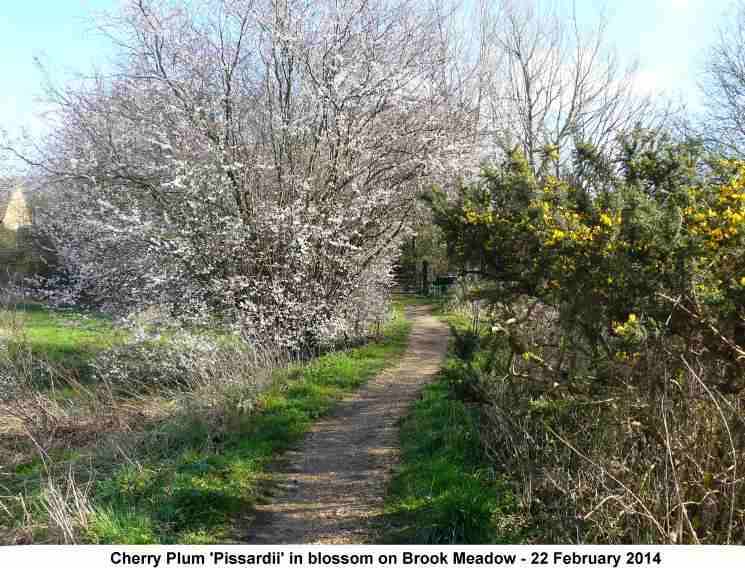
Flooding
news
On Brook Meadow, the
River Ems and the Lumley Stream are still running very
high, but the situation seems to be improving. The
flood in the south meadow is about 12 inches down on a
week ago and I gather some intrepid souls have been
venturing down the footpath again, though the water
near the gate remains quite deep.
The same also applies
further up the Ems valley. Chris Oakley checked the
water level at the road bridge in Westbourne today and
found it to be down about twelve inches from his
earlier check. The weir at the back of the church
shows a level of eight feet also a drop of twelve
inches.
Lillywhite's
path
There is also an
excellent display of Sweet Violets on the path behind
Lillywhite's Garage, by the tall brick wall. I counted
250 flowers fully open.
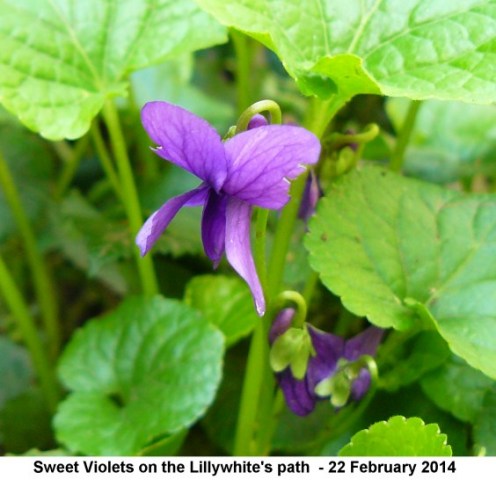
Bridge
Road car park
The verge at the
southern entrance to Bridge Road car park is looking
very attractive with a mixture of wild and cultivated
flowers. The flower bed has been planted by the
Council workers with fresh Polyanthus. In front of the
commemorative Rowan tree is a spray of small Daffodils
in memory of Margaret Gibb-Gray. At the rear of the
verge and beneath the Beech hedge there is a
developing display of Lesser Celandines - I counted 70
flowers open in the bright sunshine this morning. Also
flowering on the grass verge are Common Field
Speedwell, Hairy Bittercress, Shepherd's Purse, Daisy
and Groundsel. While I was in the car park, a Kestrel
flew overhead heading south west.

FRIDAY
FEBRUARY 21 - 2014
Harbour
birds
This morning, I got
the bike out and cycled down to the harbour with the
scope. But it was too windy and cold for easy
birdwatching. The tide was rising to high water at
15:00. Common Redshank and an unringed Greenshank were
feeding in the town channel beneath the quay. At least
400 Brent Geese were scattered around the main
channel - no doubt, having exhausted their inland
feeding sites and returned to the harbour. No sign of
any Black-tailed Godwits or other waders apart from a
few Turnstone foraging around in the seaweed. I doubt
we shall see the godwits in Emsworth again this
winter.
Wayside
flowers
There is now a very
fine display of flowering Winter Heliotrope on
the A259 embankment wayside near the centre of
Emsworth. I counted 130 flowering spikes when I passed
this morning. I think these plants have been on this
embankment for some years, probably since the road
(usually referred to ironically as the 'inner by
pass') was constructed in the early 1970s. They are
the best display in Emsworth.
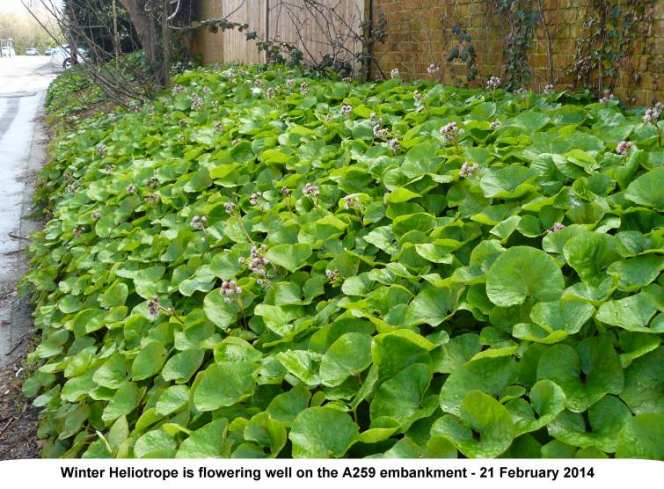
There is a very
attractive patch of Crocuses in full flower on
the Lumley Path north of Peter Pond.
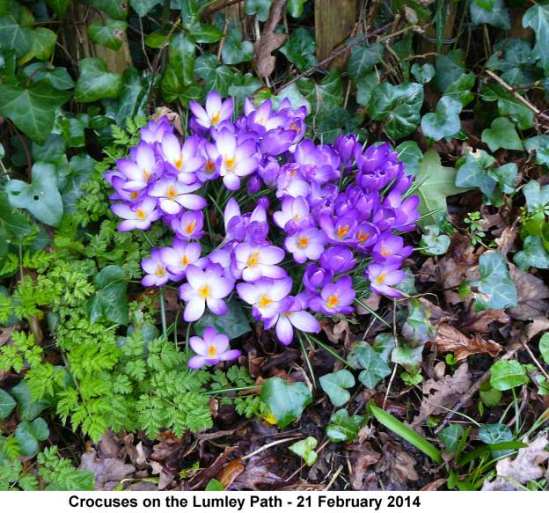
Swan
attack
Stephanie Bennett saw
another swan attack on the town millpond this
afternoon - one of the swans based in the southern
section of the pond attacked either the lone swan, or
its friend that has been keeping it company the last
few months. The attacking swan pursued the other one
for at least 30 minutes - mainly biting its neck and
wings numerous times. Stephanie says the lone swan
eventually got away but it took many attempts for it
to escape as the south swan appeared quicker and
stronger. The swan 'victim' eventually escaped onto
the Bridgefoot Path verge, its usual home, and
commenced preening and recovering from its ordeal.
Blackcap
in garden
There seem to be fewer
Blackcaps in gardens during this mild winter than
normal. I have yet to see one in my garden, though I
know other people have seen them. Romney Turner had
her first male Blackcap in her garden this morning;
last year she had 3 males and a female. Romney could
not get to her camera ready for today's bird, so she
sent me a pic of one last year on a fir tree through
the window.
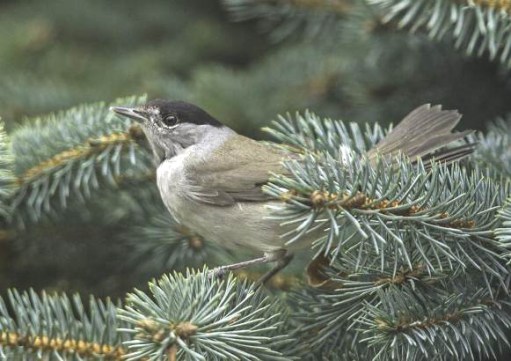
THURSDAY
FEBRUARY 20 - 2014
BROOK
MEADOW
Work
session
I just caught the end
of the morning work session as the volunteers were
packing up their tools. They are to be commended for
working through a very wet morning.
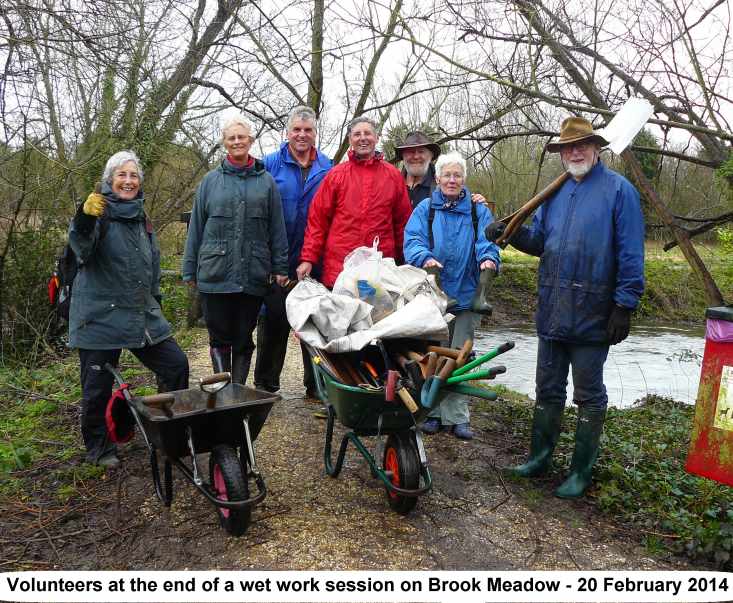
One job they did was
to repair the hazardous north path that runs from the
north bridge to the north-east corner using the gravel
from bags by the Seagull Lane gate. This path had
become very muddy and damaged by the rain over the
past few weeks.
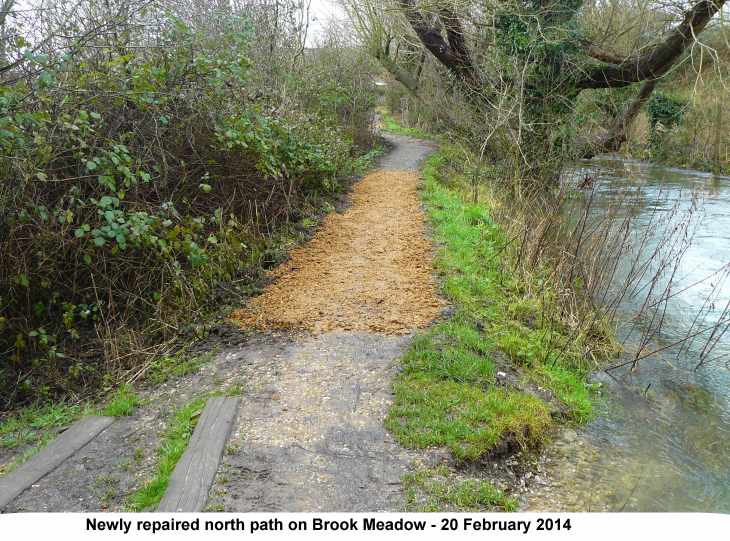
Another job was to
move the cut willow branches that had been stacked in
the north-east corner by the railway tunnel to a less
prominent place where they would be less likely to get
thrown into the river. I went back after the
volunteers had finished and found a friendly Robin
foraging in the newly cleared area.
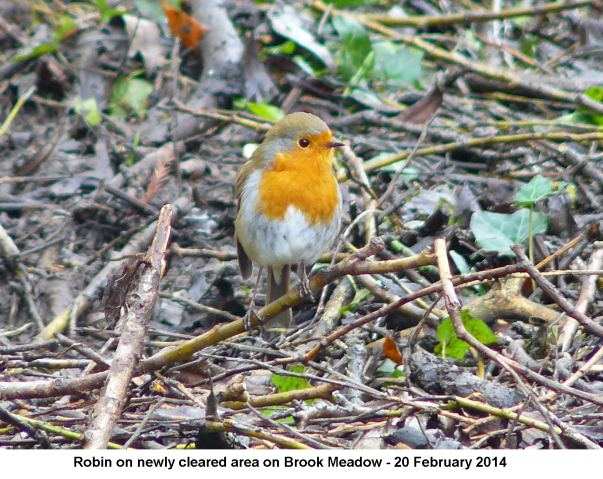
For the full report on
the workday go to . . . http://www.brook-meadow.hampshire.org.uk/bm-diary-2014a.html
Flooding
news
The river level was no
higher than when I last looked at it on Feb 15. The
situation in the north-east corner was unchanged with
the water about 12 inches below the top of the bags on
the new wall. The level in the south meadow was lower
than before, so maybe we are on the way to recovery?
Bird
song
The birds were in good
voice when I walked through Brook Meadow early this
afternoon. Following the first Chaffinch song in Nore
Barn Woods yesterday, I heard a full Chaffinch
song (with run up and delivery) for the first time
on the meadow today. I was also pleased to hear my
first Blue Tit song of the year from a bush on
the main river path; it was not a full song, only the
first phase. Clearly, they are now starting up in
earnest. Other birds singing were Robin, Dunnock,
Great Tit, Song Thrush, Wren, House Sparrow,
Fungi
I came across two
examples of fungi on the Brook Meadow site. A good
growth of Many-zoned Polypore (Coriolus
versicolor) was showing well on a tree stump just
outside the Lumley gate. We frequently see this
distinctive fungus on Brook Meadow.
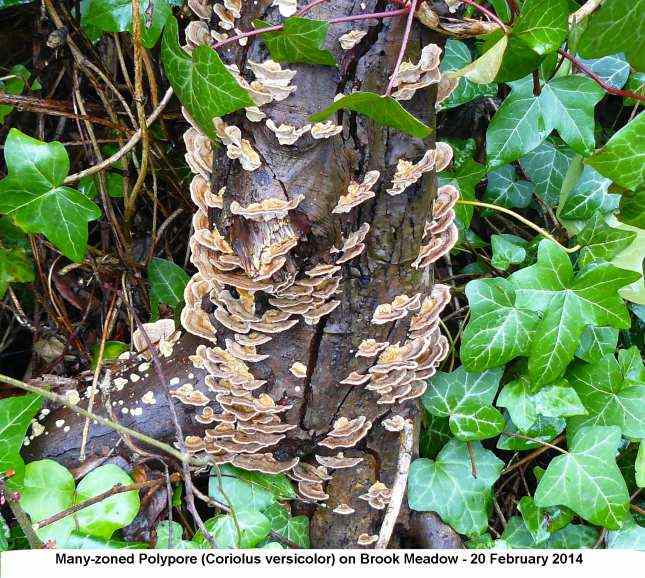
The other fungus which
I think is Straw Cup Fungus (Peziza
vesiculosa) was growing in clusters on the pile of
rotting grass arisings in the north-east corner of the
meadow. The bowl-shaped fruit bodies are
straw-coloured with wrinkled inrolled edges, thick and
tough to the touch. The inner surface is brown and
smooth with large wrinkles. Straw Cup Fungus was last
recorded on Brook Meadow in Nov-Dec 2002 also on
arisings.
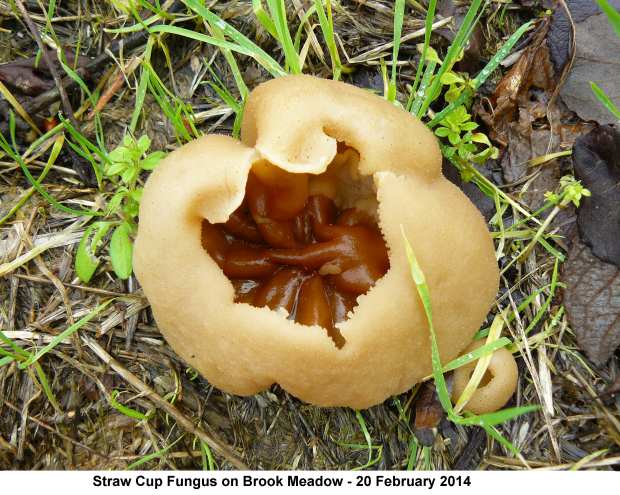
Emsworth
- Westbourne
I donned my wellies
and trudged through the muddy fields behind Westbourne
Avenue as far as Westbourne. There is nothing of
special interest to report apart from a Cormorant in
full breeding plumage with white head and roundels on
the River Ems - too far away for a photo. The fence
has gone from the Interbridges Site which means it is
now easy to walk onto the site. I recall surveying
this site a few years ago when the planning
application came up. There is no sign of any building
activity. I had a look at the waysides on the way back
home noting some wild flowers. They included Lesser
Celandines and Sweet Violets as well as many of the
common all-year-round flowers.
Nore
Barn
Peter Milinets-Raby
spent at hour down Nore Barn this afternoon just
before high tide (1pm to 2pm). He was mainly there to
check the high water to see if any of the 18 Slavonian
Grebes recently seen at Black Point by Andy Johnson
would wander up here. The answer was alas no. Birds
seen were 2 Spotted Redshanks together roosting on the
salt marsh on the opposite bank of the stream (looked
very happy if they do not get disturbed). 4 Pintail, 4
Red Breasted Merganser, Great crested Grebe, 2 Little
Grebe, 120+ Teal, 100+ Wigeon. A flock of 147 Brent
Geese came off the big field north of the wood and
alighted on the sea, possibly including the Black
Brant.
Peter's best bird was
a female Merlin which he watched for ten
minutes as it harassed the Dunlin as they departed for
their roost. He got some good scoped views as the bird
sped low over the marsh, then circled high before
drifting away towards Thorney Island. Merlin is not an
easy bird to get a good view of as it is small and
moves quickly, so it is worth keeping a look out for
it at Nore Barn as it may well return.
WEDNESDAY
FEBRUARY 19 - 2014
Blackbird
song
I heard yet another
Blackbird song this morning from a neighbouring
garden, the was the third one in the past week or so
and the fourth one this winter. Chris Oakley also has
one singing in his north Emsworth garden. So, clearly,
they are now singing widely. Ralph Hollins says this
is bang on the date when he expects regular song to
start (though he has not heard one himself as yet).
Nore
Barn
12:00 - 12:30 - Tide
well advanced and the stream was filling up. Spotted
Redshank and Greenshank were feeding together in the
stream. A Common Redshank was on the shore beyond the
saltmarshes. About 60 Wigeon were in the channel along
with a few Brent Geese and Teal.
By 12:30 the stream
was fairly full and the Spotted Redshank was
alone close to the bridge where two ladies were
standing watching it. They asked me if I knew what the
bird was. I replied, I certainly did! I explained that
it was the famous Emsworth Spotted Redshank which has
been feeding in this stream for the past 10 winters.
The ladies were so pleased to hear all this and left
saying that it had made their day! How good that a
little bird can bring such pleasure.
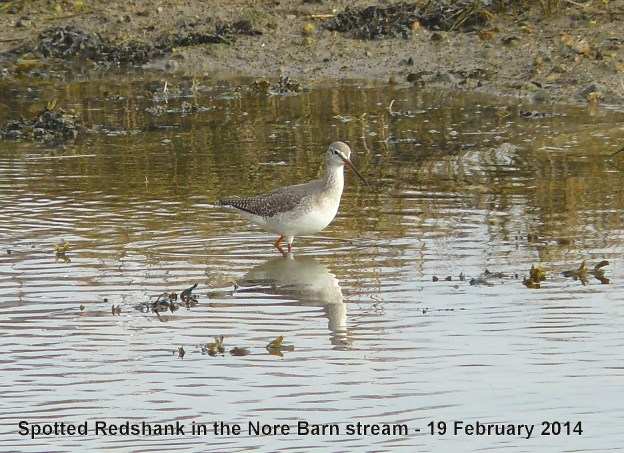
There was a nice
showing of the pink Sweet Violets at the
western end of the woods. In addition to the regular
patch I found a new patch a bit further to the east
which I have not seen before. Ralph Hollins says these
are an intermediate form between the normal violet
colour and the pure pink form.
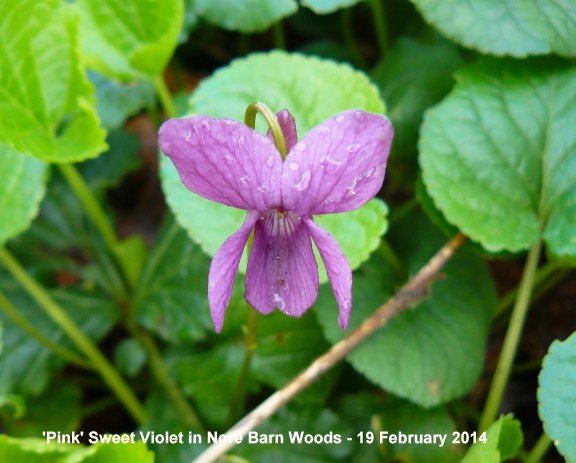
I have been waiting to
hear a Chaffinch song, but this morning in Nore
Barn Woods three were singing. Not the full song, but
borrowing the bowler analogy, the run up was there but
not always the delivery.
Hayling
beach
Chris Oakley was on
Hayling beach again today where he found yet another
dead Guillemot (without rings or tags). He also
spotted another one of the blue Squat Lobsters which
have been a matter of much discussion recently in this
blog. The tide being low exposed a lot of sand and
Chris counted 17 Oystercatchers and 15 Sanderling
feeding together with a group of gulls. Not all of
them are on this photo.
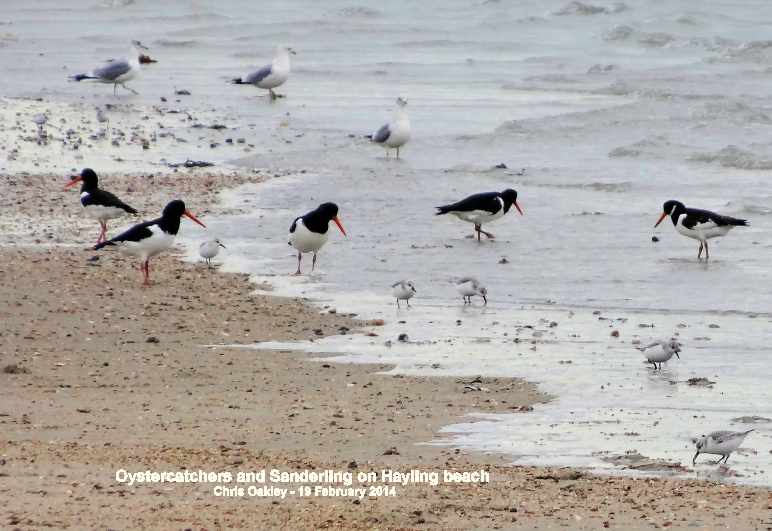
Chris says the sea
defence project has become a mammoth operation. They
are now removing gravel from the Sinah foreshore, the
full width of the island, around to Eastoke. This
seems to make sense as the shore line at the west end
of the island has been building up for years whereas
the beach at Eastoke has suffered heavy
erosion.
TUESDAY
FEBRUARY 18 - 2014
Millpond
News
Both Jennifer Rye and
Susan Kelly reported the presence of a male-female
pair of Red-breasted Mergansers on the town
millpond yesterday morning. The first pair of the
winter, though a female has been here several times.
I had a walk round the
millpond this afternoon. There was no sign of the
Red-breasted Mergansers. I keep missing them! It was
school half-term holiday and there were good numbers
of children with parents feeding the birds. The
Black-headed Gulls were certainly enjoying the feast.
I kept a good watch on them but did not see any with
leg rings.
Sadly for the
children, the large flock of swans that used to enjoy
the food are no more. All we have now are the two
pairs of warring Mute Swans. This afternoon I
watched the south pair (that now occupy the southern
part of the pond) come surging northwards, menacingly
with wings raised towards the north pair. It looked as
if there would be violence, but the aggression
dissipated once they were close. The two males
departed a short distance away for a bout of sparing,
but nothing more happened while I was there.
Certainly, nothing of the fighting that Stephanie
Bennett has witnessed.
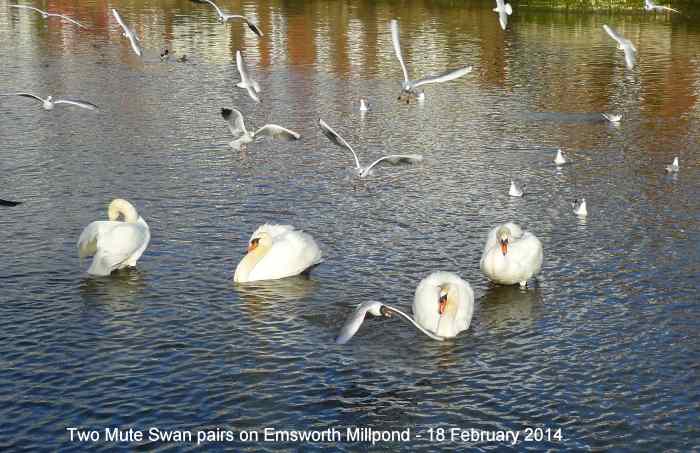
Squat
Lobster
Ralph Hollins
responded to yesterday's item about the Squat Lobster
that Chris Oakley found on Hayling beach.
He says, "Before your mention of Galathea
strigosa I had only come across (from other
people's reports) one species of Squat Lobster which
is Galathea squamifera and I suggest
that this is a likely candidate for Chris Oakley's
recent find because it is the common species around
our coasts and because strigosa is generally much
bigger. My Country Life Guide to the Seashore gives
the length of strigosa as 'up to 12 cm but often
smaller' where it gives the length of squamifera as
'up to 4.5 cm' which agrees with the 'three fingers
width' size in your photo. I don't think you can rely
on colour in the dead specimen shown but strigosa is
illustrated as being a bright orange-red with
occasional streaks of dark blue"
Here
is Chris's photo of the lobster.
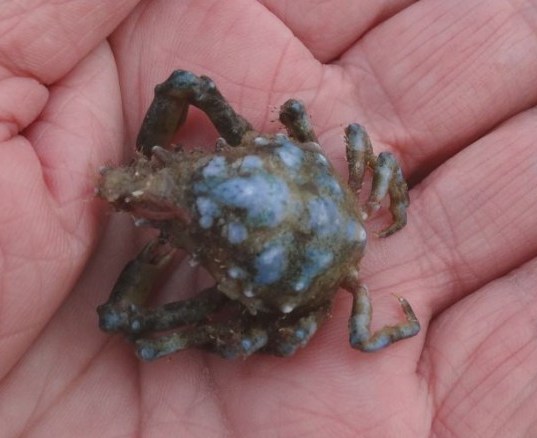
Ralph referred to a
web site which makes the point that the Common Squat
Lobster is not a lobster at all and is far more
closely related to hermit and true crabs. "It is a
cross between a crab and lobster with a flattened body
and a tail that is tucked underneath itself. The squat
lobster has 5 pairs of pereiopods (legs) although only
4 pairs can be seen from the animal's upper surface.
The front pair of pereiopods are very long with a set
of large claws. The colour of this primarily filter
feeding animal is brown with a green tint, although
juveniles are often reddish in appearance. The total
body length including the tail is up to 6cm." See . .
. http://www.norfolkwildlifetrust.org.uk/Wildlife-in-Norfolk/Species/Marine-Invertebrates/Common-Squat-Lobster.aspx
I agree the small size
certainly seems to point conclusively to Galathea
squamifera (Common Squat Lobster) as the correct
identification. However, I remain puzzled by the
distinctly blue colouring of both the creatures
photographed by Heather Mills and by Chris Oakley
which is the colour of Spiny Squat Lobster Galathea
strigosa.
MONDAY
FEBRUARY 17 - 2014
Nore
Barn
10:00 - 11:00 - I
cycled over to Nore Barn where the tide was coming in
fast. From the end of Warblington Road I could see a
huge flock of Knot far out on the decreasing
mudflats. I did not have chance to count them, but I
would say there were considerably more than the 770
that I counted on Feb 11, probably more like 1,000.
They were a most impressive sight when they all went
up - just like being at Snettisham!
Closer in were good
numbers of Brent Geese, Wigeon and Teal with a pair of
Pintail. A couple of hundred Dunlin were feeding along
the edges of the saltmarshes. The two regular
Spotted Redshanks were in the stream, feeding in
close company. I saw just one unringed Greenshank at
the top of Nore Barn Creek.
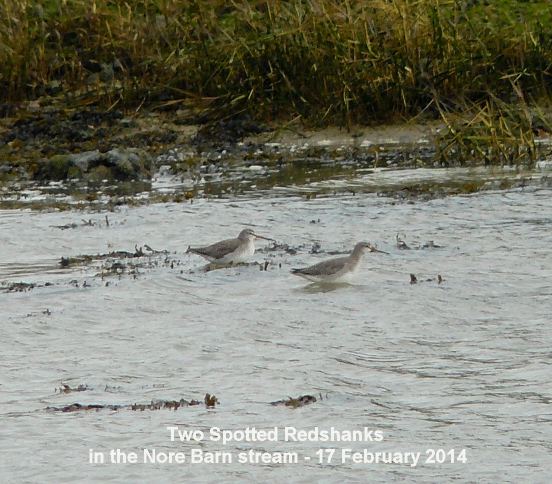
While I was there I
met members of the Nore Barn Woods conservation group
digging out an old pond with an island in the middle
that they had discovered in the middle of the reedbeds
to the north of the stream.
Here
are Barry King-Smith and Roy Ewing at work on the pond
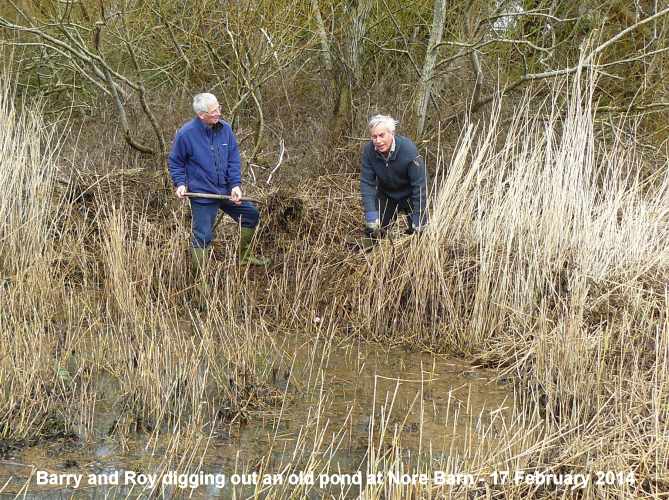
While cycling home
from Nore Barn I heard another Blackbird
singing from a garden along Warblington Road.
That's the second over the past two days. Are they
starting early?
Swan
fights
Stephanie Bennett says
she just about survived the town millpond bursting on
Friday evening with water just 1ft outside her front
and back doors in Bath Road. On the millpond she has
been witnessing some nasty swan fights in the last 2-3
weeks. One of the pair swans now dominating the south
of the pond nearly drowned the 'lone swan' recently -
that's the one that usually resides on the grass verge
outside number 14 Bridgefoot Path. More recently
Stephanie witnessed both of the south swans gang up on
one of the north pair of swans and almost drown it.
Scary stuff, she says! I suspected this would happened
as nesting time gets nearer and the hormones start to
race.
Stephanie also has not
seen the millpond cygnet for about a week, maybe
longer. There was a cygnet at Nore Barn this morning
with two parents, which I think was the one from last
year's Peter Pond brood. I think it is likely that the
cygnet will have moved off the pond, or have been
driven off by the warring swans.
First
Brimstone
Caroline French had a
walk around Compton yesterday and saw her first
Brimstone of the year. She says John Goodspeed also
reported one in Waterlooville yesterday. Caroline also
had a Common Wasp, three Brown Hares, one Redwing, and
the call of a Raven. There was a cluster of violets in
flower which Caroline was not sure about, but they
would almost certainly be Sweet Violets which are the
earliest of the violets to flower.
Hayling
beach
Chris Oakley went for
a very blowy walk along Hayling beach this morning.
The shore was in turmoil with heavy lorries moving
vast amounts of gravel. Chris found another two
dead Guillemots on the beach - he also found one
here on Jan 16. Neither had tags or rings.
Chris also came across
a crab-like creature on the beach with a distinctly
blue pattern on its back and legs. The Havant Wildlife
Group found a very similar blue crab (with
'passengers') on Southsea beach on Feb 8. Chris thinks
that neither of these creatures are crabs, but are
Squat Lobsters (family galatheidae). I agree and think
we can narrow them down to Spiny Squat Lobsters
(Galathea strigosa) which have these blue
markings and which are common on all coasts in rocky
areas - the recent storms must have washed them up on
our local beaches.
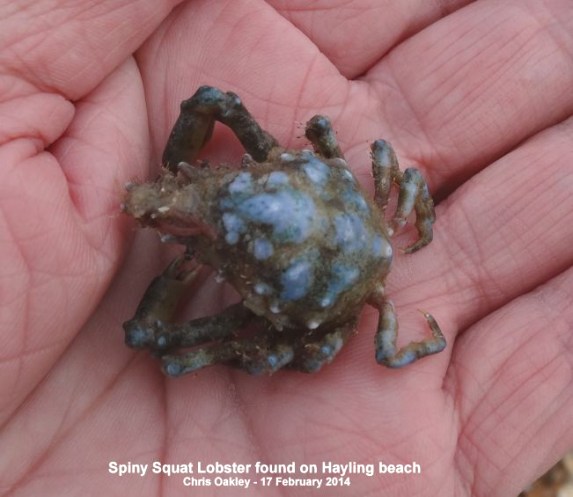
SUNDAY
FEBRUARY 16 - 2014
Lesser
Celandines
It was good to see the
first Brook Meadow Lesser Celandine yesterday
struggling to show its yellow petals among the mud and
water. There was a much brighter showing this morning
in Bridge Road where a good 20 blossoms have opened to
greet the sun. They are in the usual spot beneath the
Beech hedge at the southern entrance to the car park.
The first verse of Wordsworth's famous poem seems
particularly apt on this sunny day following all the
awful weather.
"There is a Flower,
the Lesser Celandine,
That shrinks, like many more, from cold and rain;
And, the first moment that the sun may shine,
Bright as the sun himself, 'tis out again!"
Here is a photo of one
flower with its 11 petals shining brightly in the
morning sunshine. The number of petals on Celandines
vary from 7 to 13.
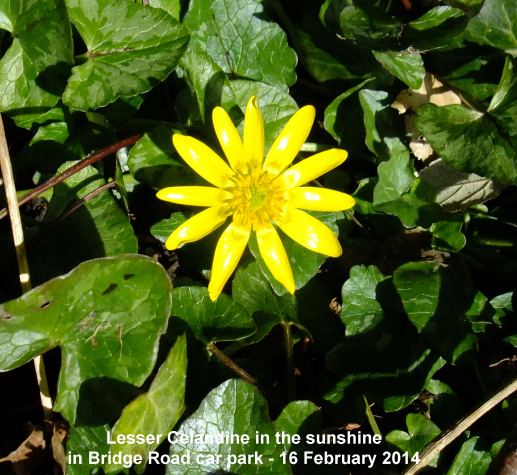
I was also pleased to
a Blackbird singing its relaxed flutey song from the
bushes in Bridge Road car park - what a fine songster.
Fossil
find
Chris Oakley agrees
that none of the stones he collected from the
Hampshire Farm site were fossils. However, he does
have one true fossil from the site a Cretaceous
Echinoid (possibly sternotaxis planus). He says,
this came to light when they were digging the pond;
initially, they cut through the clay into the shingle
layer some fifteen feet down, but later they
re-leveled the pond base to around eight
feet.
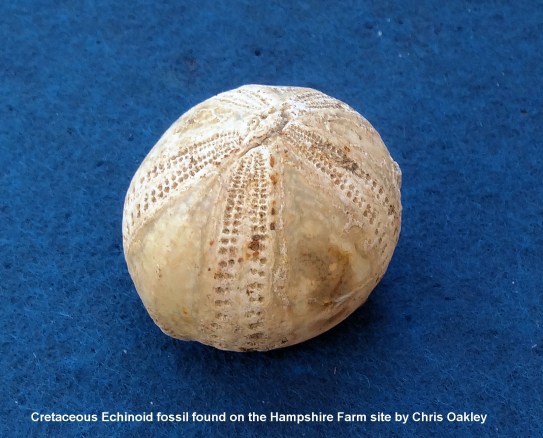
Godwits
return
Heather Mills was at
Farlington Marshes today and came across about 300
Black-tailed Godwits - so they are returning from the
flooded fields, but not yet to Emsworth.
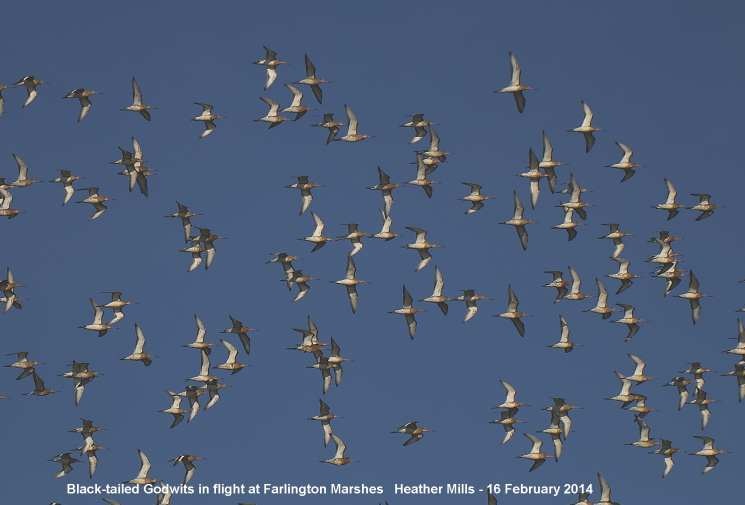
For
earlier observations go to . . . February
1-15